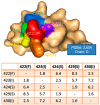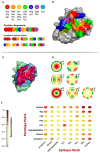Recent Progress in Antibody Epitope Prediction
- PMID: 37606436
- PMCID: PMC10443277
- DOI: 10.3390/antib12030052
Recent Progress in Antibody Epitope Prediction
Abstract
Recent progress in epitope prediction has shown promising results in the development of vaccines and therapeutics against various diseases. However, the overall accuracy and success rate need to be improved greatly to gain practical application significance, especially conformational epitope prediction. In this review, we examined the general features of antibody-antigen recognition, highlighting the conformation selection mechanism in flexible antibody-antigen binding. We recently highlighted the success and warning signs of antibody epitope predictions, including linear and conformation epitope predictions. While deep learning-based models gradually outperform traditional feature-based machine learning, sequence and structure features still provide insight into antibody-antigen recognition problems.
Keywords: antibody; antibody design; artificial intelligence; epitope.
Conflict of interest statement
The authors declare no conflict of interest.
Figures



Similar articles
-
Multi-state modeling of antibody-antigen complexes with SAXS profiles and deep-learning models.Methods Enzymol. 2023;678:237-262. doi: 10.1016/bs.mie.2022.11.003. Epub 2022 Dec 8. Methods Enzymol. 2023. PMID: 36641210
-
Deep learning of antibody epitopes using positional permutation vectors.Comput Struct Biotechnol J. 2024 Jun 15;23:2695-2707. doi: 10.1016/j.csbj.2024.06.005. eCollection 2024 Dec. Comput Struct Biotechnol J. 2024. PMID: 39035832 Free PMC article.
-
Machine-learning-based Structural Analysis of Interactions between Antibodies and Antigens.bioRxiv [Preprint]. 2023 Dec 8:2023.12.06.570397. doi: 10.1101/2023.12.06.570397. bioRxiv. 2023. Update in: Biosystems. 2024 Sep;243:105264. doi: 10.1016/j.biosystems.2024.105264. PMID: 38106177 Free PMC article. Updated. Preprint.
-
Machine learning-based methods for prediction of linear B-cell epitopes.Methods Mol Biol. 2014;1184:217-36. doi: 10.1007/978-1-4939-1115-8_12. Methods Mol Biol. 2014. PMID: 25048127 Review.
-
Sagacious epitope selection for vaccines, and both antibody-based therapeutics and diagnostics: tips from virology and oncology.Antib Ther. 2022 Feb 21;5(1):63-72. doi: 10.1093/abt/tbac005. eCollection 2022 Jan. Antib Ther. 2022. PMID: 35372784 Free PMC article. Review.
Cited by
-
Development of the PD9-9 Monoclonal Antibody for Identifying Porcine Bone Marrow-Derived Dendritic Cells.Life (Basel). 2024 Aug 23;14(9):1054. doi: 10.3390/life14091054. Life (Basel). 2024. PMID: 39337839 Free PMC article.
-
Diagnostics of Allergy to Furry Animals-Possibilities in 2024.J Clin Med. 2024 May 30;13(11):3239. doi: 10.3390/jcm13113239. J Clin Med. 2024. PMID: 38892951 Free PMC article. Review.
-
Peptide Antibodies: Current Status.Methods Mol Biol. 2024;2821:1-8. doi: 10.1007/978-1-0716-3914-6_1. Methods Mol Biol. 2024. PMID: 38997476
-
Monoclonal antibodies: From magic bullet to precision weapon.Mol Biomed. 2024 Oct 11;5(1):47. doi: 10.1186/s43556-024-00210-1. Mol Biomed. 2024. PMID: 39390211 Free PMC article. Review.
-
Unlocking the potential of in silico approach in designing antibodies against SARS-CoV-2.Front Bioinform. 2025 Feb 13;5:1533983. doi: 10.3389/fbinf.2025.1533983. eCollection 2025. Front Bioinform. 2025. PMID: 40017562 Free PMC article. Review.
References
-
- Liu J., Yang S., Cao B., Zhou G., Zhang F., Wang Y., Wang R., Zhu L., Meng Y., Hu C., et al. Targeting B7-H3 via chimeric antigen receptor T cells and bispecific killer cell engagers augments antitumor response of cytotoxic lymphocytes. J. Hematol. Oncol. 2021;14:21. doi: 10.1186/s13045-020-01024-8. - DOI - PMC - PubMed
-
- Zhu L., Liu J., Zhou G., Ng H.M., Ang I.L., Ma G., Liu Y., Yang S., Zhang F., Miao K., et al. Targeting immune checkpoint B7-H3 antibody-chlorin e6 bioconjugates for spectroscopic photoacoustic imaging and photodynamic therapy. Chem. Commun. 2019;55:14255–14258. doi: 10.1039/C9CC06839B. - DOI - PubMed
-
- Cao B., Liu M., Wang L., Zhu K., Cai M., Chen X., Feng Y., Yang S., Fu S., Zhi C., et al. Remodelling of tumour microenvironment by microwave ablation potentiates immunotherapy of AXL-specific CAR T cells against non-small cell lung cancer. Nat. Commun. 2022;13:6203. doi: 10.1038/s41467-022-33968-5. - DOI - PMC - PubMed
Publication types
Grants and funding
LinkOut - more resources
Full Text Sources

